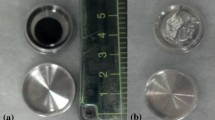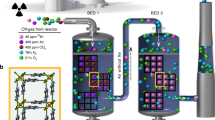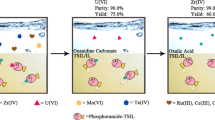Abstract
Typical fission product formation experiments utilize metal or oxide target materials that must be dissolved prior to product separation. We report here a novel study using metal–organic frameworks for recovery of fission products into acidic media. We further show that the frameworks are largely preserved, such that this bulk target material could be retained for additional irradiations or characterizations. Through this approach, fission products can be separated from the actinide-based metal–organic framework using 0.01 M HNO3 without the need to dissolve the framework itself, reducing the amount of acidic waste. Extraction yields of four frameworks with varying pore sizes are compared. The results suggest that it may be possible to use porous frameworks as target materials for the extraction of select fission products.






Similar content being viewed by others
References
Abdelrasoul A, Zhang H, Cheng CH, Doan H (2017) Microporous Mesoporous Mater 242:294
Custelcean R, Moyer BA (2007) Eur J Inorg Chem 2007(10):1313–1317
Kulprathipanja S (2010) Zeolites in industrial separation and catalysis. Wiley-VCH Verlag GmbH & Co.KGaA, Weinheim
Pina MP, Arruebo M, Mallada R (2015) Handbook of membrane separations. CRC Press, Boca Raton
Yu J, Xie LH, Li JR, Ma Y, Seminario JM (2017) CO2 capture and separations using MOFs: computational and experimental studies. Chem Rev 117(14):9674–9754
Li X, Liu Y, Wang J, Gascon J, Li J, Van der Bruggen B (2017) Metal–organic frameworks based membranes for liquid separation. Chem Soc Rev 46(23):7124–7144. https://doi.org/10.1039/C7CS00575J
Peng Y, Huang H, Zhang Y, Kang C, Chen S, Song L, Liu D, Zhong C (2018) A versatile MOF-based trap for heavy metal ion capture and dispersion. Nat Commun 9(1):187. https://doi.org/10.1038/s41467-017-02600-2
Farrusseng D (ed) (2011) Metal organic frameworks: applications from catalysis to gas storage. Wiley-VCH, Weinheim
Cahill CL, Borkowski LA (2007) U(VI)-containing metal organic frameworks and coordination polymers. In: Krivovichev S, Burns P, Tananaev I (eds) Structural chemistry of inorganic actinide compounds, 1st edn. Elsevier, Amsterdam
Cantos PM, Frisch M, Cahill CL (2010) Synthesis, structure and fluorescence properties of a uranyl-2,5-pyridinedicarboxylic acid coordination polymer: the missing member of the UO22+-2, n-pyridinedicarboxylic series. Inorg Chem Commun 13(9):1036–1039. https://doi.org/10.1016/j.inoche.2010.06.004
Frisch M, Cahill CL (2006) Synthesis, structure and fluorescent studies of novel uranium coordination polymers in the pyridinedicarboxylic acid system. Dalton Trans 39:4679–4690. https://doi.org/10.1039/B608187H
Kerr AT, Cahill CL (2011) Crystal engineering with the uranyl cation III. Mixed aliphatic dicarboxylate/aromatic dipyridyl coordination polymers: synthesis, structures, and speciation. Cryst Growth Des 11(12):5634–5641. https://doi.org/10.1021/cg2011869
Thuéry P (2009) Uranyl–organic bilayer assemblies with flexible aromatic di-, tri- and tetracarboxylic acids†. CrystEngComm 11:1081–1088. https://doi.org/10.1039/b821895a
Thuéry P (2009) Two novel uranyl-organic frameworks with cyclohexane-1,3-dicarboxylate ligands. CrystEngComm 11:1081–1088
Thuéry P (2011) Uranyl–organic assemblies with acetate-bearing phenyl- and cyclohexyl-based ligands. Cryst Growth Des 11(1):347–355. https://doi.org/10.1021/cg101344t
Thuéry P (2011) Uranyl ion complexation by aliphatic dicarboxylic acids in the presence of cucurbiturils as additional ligands or structure-directing agents. Cryst Growth Des 11(6):2606–2620. https://doi.org/10.1021/cg200349p
Thuéry P (2012) Uranyl ion complexes with ammoniobenzoates as assemblers for cucurbit [6] uril molecules. Cryst Growth Des 12:499–507
Thuéry P (2012) Uranyl-organic one- and two- dimensional assemblies with 2,2′-bipyridine-3,3′-dicarboxylic, biphenyl-3,3′,4,4′-tetracarboxylic and bicyclo[2.2.2]oct-7-ene-2,3,5,6-tetracarboxylic acids. CrystEngComm 14:131–137
Dolgopolova EA, Ejegbavwo OA, Martin CR, Smith MD, Setyawan W, Karakalos SG, Henager CH, zur Loye H-C, Shustova NB (2017) Multifaceted modularity: a key for stepwise building of hierarchical complexity in actinide metal–organic frameworks. J Am Chem Soc 139(46):16852–16861. https://doi.org/10.1021/jacs.7b09496
MacGillivray LR (2010) Metal organic frameworks: design and application. Wiley, Hoboken
Sheldrick G (2008) A short history of SHELX. Acta Crystallogr Sect A 64(1):112–122. https://doi.org/10.1107/S0108767307043930
Hutcheon ID, Grant PM, Moody KJ (2011) Handbook of nuclear chemistry. Springer, Boston
Dorhout JM, Wilkerson MP, Czerwinski KR (2018) A UO2-based salt target for rapid separation of fission products. J Radioanal Nucl Chem 319(3):1291–1300
Volkringer C, Falaise C, Devaux P, Giovine R, Stevenson V, Pourpoint F, Lafon O, Osmond M, Jeanjacques C, Marcillaud B, Sabroux JC, Loiseau T (2016) Stability of metal–organic frameworks under gamma irradiation. Chem Commun 52(84):12502–12505. https://doi.org/10.1039/C6CC06878B
Doty FP, Bauer CA, Grant PG, Simmons BA, Skulan AJ, Allendorf MD (2007) Radioluminescence and radiation effects in metal organic framework materials. In: Optical Engineering + Applications, 2007. SPIE, p 8
Mihalcea I, Henry N, Volkringer C, Loiseau T (2011) Uranyl–pyromellitate coordination polymers: toward three-dimensional open frameworks with large channel systems. Cryst Growth Des 12:526–535
Sheldrick GM (2001) SADABS 2.03. University of Gottingen, Gottingen
Sheldrick GM (2008) Acta Crystallogr Sect A: Found Crystallogr 64:112–122
Gibson MA, Briggs MH, Sanzi JL, Brace MH (2013) Heat pipe powered stirling conversion for the demonstration using flattop fission (DUFF) test. In: Presentation given at the topical meeting: Nuclear and emerging technologies for space (NETS-2013) cosponsored by the American Nuclear Soceity and Aerojet, Albuquerque, NM, February 25–28 2013
Hayes DK, Myers WL (2012) NCERC capabilities and status July 2012. In: Institute of nuclear materials management 53rd annual meeting, Orlando, Florida, 2012
Loaiza D, Gehman D (2006) End of an Era for the Los Alamos critical experiments facility: history of critical assemblies and experiments (1946–2004). Ann Nucl Energy 33(17):1339–1359. https://doi.org/10.1016/j.anucene.2006.09.009
Malenfant RE (1981) Los Alamos critical assemblies facilities. Los Alamos Scientific Laboratory, Los Alamos
Immirzi A, Bombieri G, Degetto S, Marangoni G (1975) The crystal and molecular structure of pyridine-2,6-dicarboxylatodioxouranium(VI) monohydrate. Acta Crystallogr Sect B 31(4):1023–1028. https://doi.org/10.1107/S0567740875004426
Cantos PM, Frisch M, Cahill CL (2010) Inorg Chem Commun 13:1036
Kerr AT, Cahill CL (2011) Crystal Engineering with the uranyl cation III. Mixed aliphatic dicarboxylate/aromatic dipyridyl coordination polymers: synthesis, structures, and speciation. Crystal Growth Des 11(12):5634–5641. https://doi.org/10.1021/cg2011869
Mihalcea I, Henry N, Volkringer C, Loiseau T (2012) Uranyl–pyromellitate coordination polymers: toward three-dimensional open frameworks with large channel systems. Cryst Growth Des 12(1):526–535. https://doi.org/10.1021/cg201509v
Furukawa H, Cordova KE, O’Keeffe M, Yaghi OM (2013) The chemistry and applications of metal–organic frameworks. Science 341:6149. https://doi.org/10.1126/science.1230444
Barbalace K (1995) Periodic table of elements—sorted by ionic radius. https://EnvironmentalChemistry.com/yogi/periodic/ionicradius.html. Accessed 13 Nov 2018
Baum EM, Ernesti MC, Knox HD, Miller TR, Watson AM, Travis SD (2009) Nuclides and isotopes: chart of the nuclides. Bechtel Marine Propulsion Corporation, Richmond
Shahroosvand H, Nasouti F, Mohajerani E, Khabbazi A (2012) Synthesis, characterization and optical properties of novel N donor ligands-chelated zirconium(IV) complexes. Opt Mater 35(1):79–84. https://doi.org/10.1016/j.optmat.2012.07.006
Smirnova OV, Sukhova TA, Solov’ev MV, Galibeev SS, Gagieva SC, Tuskaev VA, Bulychev BM (2011) Titanium(4+) and zirconium(4+) dichloride complexes with pyridinedicarboxylic acid derivatives as ethylene polymerization catalysts. Russian J Inorg Chem 56(4):555–557. https://doi.org/10.1134/s0036023611040255
Xu T, Wu B, LGe L, Wang X, Xu T (2018) Double organic ligand MOF and its preparation method, double organic ligand charged MOF and its preparation method. People’s Republic of China Patent
Rzączyńska Z, Danczowska-Burdon A, Sienkiewicz-Gromiuk J (2010) Thermal and spectroscopic properties of light lanthanides(III) and sodium complexes of 2,5-pyridinedicarboxylic acid. J Therm Anal Calorim 101(2):671–677. https://doi.org/10.1007/s10973-010-0941-3
Zhang Y-H, Di Y-Y, Tan Z-C, Dou J-M (2014) Synthesis, crystal structure and thermochemistry of the coordination compound of pyridine-2,6-dicarboxylic acid with barium ion. Thermochim Acta 575:173–178. https://doi.org/10.1016/j.tca.2013.10.034
Ye J, League A, Truhlar D, Cramer C, Gagliardi L, Bernales V, Farha O, Hupp J, Li Z, Platero Prats AE, Chapman K, Camaioni D, Fulton J, Lercher J (2017) Computational study of a MOF-supported single site Ni catalyst for ethylene dimerization. Paper presented at the 254th ACS national meeting & exposition, Washington, DC, August 20–24, 2017
Shalini S, Nandi S, Justin A, Maity R, Vaidhyanathan R (2018) Potential of ultramicroporous metal–organic frameworks in CO2 clean-up. Chem Commun. https://doi.org/10.1039/c8cc03233e
Furukawa H, Cordova KE, O’Keeffe M, Yaghi OM (2013) Science 341(6149):1230444
Dorhout JM (2017) Synthesis of actinide materials for the study of basic actinide science and rapid separation of fission products. University of Nevada - Las Vegas, Las Vegas
Acknowledgements
We would like to acknowledge Dr. D. Mast (UNLV) for single crystal analysis, Dr. T. Bredeweg (LANL) for provision of the sample holders, as well as help with the irradiations, and J. Bertoia (UNLV), T. Low (UNLV), R. Springs (UNLV), and Dr. D. Lowe (Varex) for their help with gamma-ray spectroscopy. This research was completed as part of the dissertation work for JMD [48]. For financial support of this work, we acknowledge the LANL G. T. Seaborg Institute for Transactinium Science (graduate funding to JMD), and the Domestic Nuclear Detection Office under competitively awarded contract IAA: HSHQDC-16-X-00088 (post-doctoral funding to JMD). This material is based upon work supported by the U.S. Department of Homeland Security under Grant Award Number, 2012-DN-130-NF0001. The views and conclusions contained in this document are those of the authors and should not be interpreted as representing the official policies, either expressed or implied, of the U.S. Department of Homeland Security. We also acknowledge the Development of a Synthetic Debris for Nuclear Forensics, Prime Contract No. DE-AC52-06NA25946, Subcontract No. 104777 Task Order 41. Los Alamos National Laboratory is operated by Triad National Security, LLC. for the National Nuclear Security Administration for the U.S. Department of Energy (Contract DE-SOL-0011206). LA-UR-18-30985.
Author information
Authors and Affiliations
Corresponding author
Ethics declarations
Conflict of interest
The authors declare that they have competing interest.
Additional information
Publisher's Note
Springer Nature remains neutral with regard to jurisdictional claims in published maps and institutional affiliations.
Electronic supplementary material
Below is the link to the electronic supplementary material.
Rights and permissions
About this article
Cite this article
Dorhout, J.M., Wilkerson, M.P. & Czerwinski, K.R. Irradiation and isolation of fission products from uranium metal–organic frameworks. J Radioanal Nucl Chem 320, 415–424 (2019). https://doi.org/10.1007/s10967-019-06478-w
Received:
Published:
Issue Date:
DOI: https://doi.org/10.1007/s10967-019-06478-w




